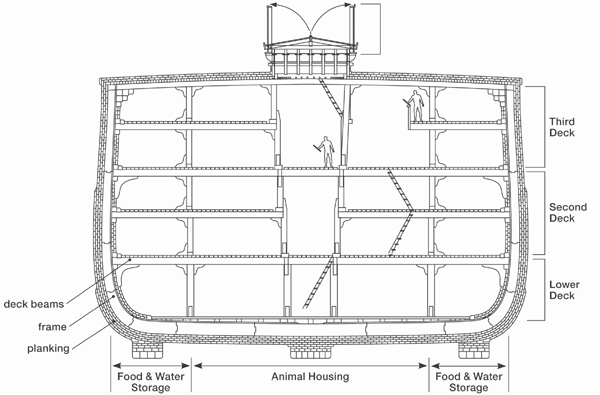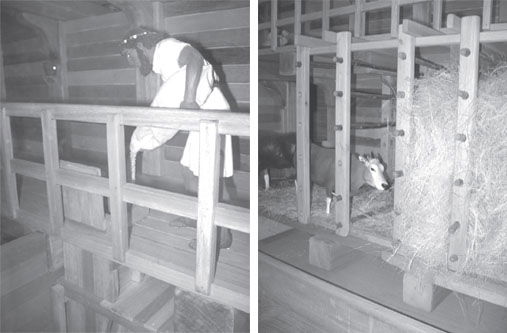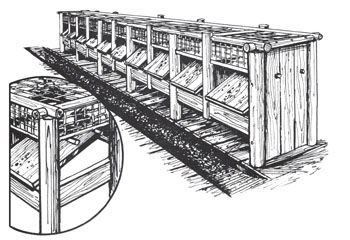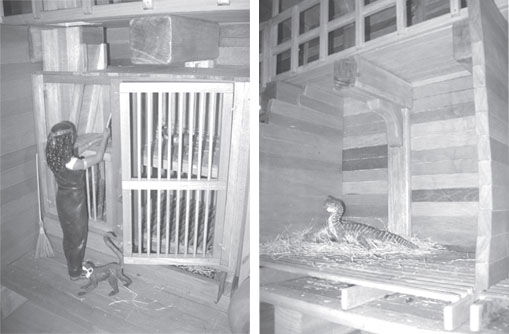Noah's Ark a Feasibility Study Free to Read Online
While it is possible that God made miraculous provisions for the daily care of these animals, it is not necessary—or required by Scripture—to entreatment to miracles.
[Editor'southward Note (July 2016): Run across the latest research by AiG's Ark Meet researchers on Ark animals, size, logistics, and other details at ArkEncounter.com.]
Co-ordinate to Scripture, Noah's ark was a condom oasis for representatives of all the kinds of air-breathing state animals and birds that God created. While information technology is possible that God fabricated miraculous provisions for the daily care of these animals, it is not necessary—or required by Scripture—to appeal to miracles. Exploring natural solutions for day-to-day operations does not disbelieve God'south role: the biblical business relationship hints at enough of miracles equally written, such as God bringing the animals to the ark (Genesis 6:20; 7:nine, 15), closing the door of the ark (Genesis 7:xvi), and causing the fountains of the deep and the windows of heaven to open on the same twenty-four hour period (Genesis 7:11). Information technology turns out that a study of existing, depression-tech animal intendance methods answers trivial objections to the ark. In fact, many solutions to seemingly insurmountable problems are rather straightforward.1
How Did Noah Fit All the Animals on the Ark?
Was every species on the ark? No!
To answer this question, we must first ask how many animals were really on the ark. Critics accept fantasized the presence of millions of animals overloading the ark. In actuality, the Bible makes it clear that the cargo was limited to country-dwelling, air-breathing vertebrate animals—corresponding to modern birds, mammals, and reptiles, as well every bit their extinct counterparts.
Was every species on the ark? No! From capacity such every bit Leviticus xi, it is obvious that the created kind (min in Hebrew, in Genesis i:11–12, 21, 24–25) was a much broader category than the modern term of nomenclature, species. Current baraminological2 research suggests that the created kind most closely corresponded to the family level in electric current taxonomy. However, to be conservative in this study, the genus was ready equally equivalent to the original created kind. Equally for the clean animals that entered the ark in vii pairs, this added a pocket-size number of additional animals, notably bovids (cow-like mammals) and cervids (deer-like mammals). Under these conservative assumptions, there were no more than than 16,000 state animals and birds on the ark.
According to the Bible, the ark had three decks (floors). It is not hard to prove that there was plenty of room for xvi,000 animals, assuming they required approximately the same floor space every bit animals in typical farm enclosures and laboratories today. The vast majority of the creatures (birds, reptiles, and mammals) are small-scale. The largest animals were probably just a few hundred pounds of trunk weight.
It is even so necessary to take account of the flooring spaces required by large animals, such equally elephants, giraffes, rhinos, and some dinosaurs. But even these, collectively, do not crave a large area. God would likely have sent to Noah immature (and therefore small, but not newborn) representatives of these kinds so that they would have a full reproductive potential for life subsequently the Flood to repopulate the earth (Genesis 7:1–iii). Even the largest dinosaurs were relatively small when just a few years old.
Without tiering of cages, but 47 percent of the ark floor would have been necessary. What's more than, many could have been housed in groups, which would have further reduced the required space.
What nigh the provisions for the animals? It tin can be shown that the nutrient would have filled only vi to 12 percent of the volume of the ark, and the potable h2o simply an additional 9 percent of the same.3
What Near the Dinosaurs?
There are only several hundred genera of dinosaurs known. What's more, the continuous invalidation of old names largely offsets the continuous discovery of new kinds of dinosaur genera.iv Only a modest fraction of all dinosaurs reached behemothic size. About xvi percent of dinosaur genera had an adult weight in excess of ten tons, and almost one-half of dinosaur genera weighed no more than a ton when mature.
However, the foregoing is academic considering dinosaurs could have been represented equally young. Interestingly, according to the most contempo models of dinosaur maturation, even the largest sauropod dinosaurs were no more than several hundred kilograms in weight by the time they were just over a yr old,5 which could have corresponded to their time of release from the ark.
What Did the Dinosaurs Swallow?
Dinosaurs could have eaten basically the aforementioned foods as the other animals. The young representatives of the large sauropods could have eaten compressed hay, other dried plant material, seeds and grains, and the like. Carnivorous dinosaurs—if any were meat-eaters before the Flood—could have eaten dried meat, reconstituted dried meat, or slaughtered animals. Behemothic tortoises would have been ideal to use as food in this regard. They were big and needed little food to be maintained themselves. There are also exotic sources of meat, such as fish that wrap themselves in dry out cocoons.

Figure 1. This is a cross-department view of a possible blueprint of the interior of the ark. The proposed skylight roof could be opened. This might be the covering when "Noah removed the covering of the ark" (Genesis eight:13).
How Were the Animals Cared For?
Anti-Bible critics take compared the challenges of caring for the animals with that of modern zoos. This is fallacious. We must distinguish between the long-term care required for animals kept in zoos and the temporary, emergency care required on the ark. The animals' condolement and healthy appearance were non essential for emergency survival during i stressful yr, where survival was the primary goal.
Studies of non-mechanized brute care indicate that eight people could have fed and watered 16,000 creatures. The key is to avoid unnecessary walking around. Every bit the erstwhile adage says, "Don't piece of work harder, work smarter."
Therefore, Noah probably stored the food and water near each beast. Even better, drinking h2o could accept been piped into troughs, but as the Chinese have used bamboo pipes for this purpose for thousands of years. The apply of some sort of self-feeders, as is commonly washed for birds, would take been relatively piece of cake and probably essential. Animals that required special care or diets were uncommon and should not accept needed an inordinate amount of fourth dimension from the handlers. Even animals with the almost specialized diets in nature could accept been switched to readily sustainable substitute diets. Of course, this assumes that animals with specialized diets today were likewise specialized at the fourth dimension of the Flood. But that may non have been the instance in the ancestral kinds that were taken on the ark.

Figures 2 and 3. With Noah being over 500 years in age, it would make sense that he had the cognition to be able to comprise automatic feeding and watering systems where they merely had to be refilled occasionally.
Animals with Special Diets
Many challenges to the reliability of the biblical account of Noah's ark, based on animals' feeding requirements, are steeped in mythology. Practise convict anteaters necessarily require ants? No! Neither do nigh insect-eating animals require insects in their diet. Nor do well-nigh animals that consume only live prey in nature necessarily require moving prey in captivity. (For the few that practise, it would not have been hard to provide a rudimentary live-beast feeder.)
Even the virtually "fussy" animate being kinds today contain individual representatives that can depart from the foods their kind normally eats in nature. For example, although most koalas swallow nothing but fresh eucalyptus leaves, in that location are private koalas that will subsist on stale eucalyptus leaves. Besides, some individual pandas will accept dried bamboo stalks.
How Did the Animals Breathe?
The ventilation of the ark was not merely necessary to provide fresh air merely, more of import, to dissipate torso heat. A basic, non-mechanical ventilation system was sufficient for the ark. The density of animals on the ark, compared to the volume of enclosed space, was much less than nosotros discover in some modern, mass animal housing used to keep stock that are raised for food (such as chicken farms), which often require no special mechanical ventilation.
The Bible is non specific every bit to the kind and size of window on the ark. Information technology is reasonable to believe that one relatively small window would accept fairly ventilated the ark. Of class, if at that place were a window running along the superlative center section, which the biblical clarification allows, all occupants would be even more comfortable. It is besides interesting to note that the convective move of air, driven by temperature differences between the warm-blooded animals and the cold interior surfaces, would have been significant enough to bulldoze the menstruation of air. Plus, current of air bravado into the window would have enhanced the ventilation further. However, if supplementary ventilation was necessary, information technology could have been provided past wave motility or even a pocket-sized number of animals harnessed to slow-moving rotary fans.
What Did Noah and His Family Do with the Animal Waste?

Figure 4. Brute enclosures with sloped, self-cleaning floors, emptying into a manure gutter or pit.
As much equally 12 U.S. tons (xi g. tons) of animal waste may have been produced daily. The key to keeping the enclosures make clean was to avoid the need for Noah and his family unit to practice the piece of work. The right systems could too preclude the demand to change brute bedding. Noah could have accomplished this in several ways. One possibility would be to allow the waste to accumulate below the animals, much as we see in rustic henhouses. In this regard, there could have been slatted floors, and animals could have trampled their waste into the pits beneath. Small animals, such as birds, could accept multiple levels in their enclosures, and waste could have simply accumulated at the bottom of each.
The danger of toxic or explosive manure gases, such as methane, would exist alleviated by the constant movement of the ark, which would have immune manure gases to be constantly released. Second, methane, which is half the density of air, would quickly find its way out of the window of the ark. At that place is no reason to believe that the levels of these gases within the ark would have remotely approached hazardous levels.
Alternatively, sloped floors in fauna enclosures would have allowed the waste to flow into large central gutters and and so into collection pits, allowing gravity to do nigh of the work. Noah'south family unit could have and so dumped this overboard without an excessive expenditure of manpower.
The trouble of manure odor may, at kickoff thought, seem insurmountable. But nosotros must remember that throughout most of human history, humans lived together with their farm animals. Barns, separate from human living quarters, are a relatively recent development.
While the voyage of the ark may not have been comfortable or easy, it was certainly doable, even under such unprecedented circumstances.

Figures five and 6. Some floors could allow waste to fall below and could exist stocked with hay or sawdust to soak it up. It is possible that a clean-up would not even be required for the duration of the year-long Flood.
Did the Animals Hibernate?
If animals hibernated, this would, of course, have profoundly alleviated the need to feed, water, and remove the waste of the ark animals. Critics bespeak out that the vast majority of animals on the ark were not of the blazon that hide. However, this ignores the possibility that hibernation (or its equivalent in tropical environments, such as aestivation) may have been much more widespread in the animal kingdom than information technology is today.
It is, of course, too possible that God put the animals into a slumber for near of the time that they were on the ark. Simply all this is moot. Whether supernatural or natural, hibernation was not necessary for the animals to take been adequately cared for on the ark. It only would take fabricated it easier.
Were Single Pairs Sufficient?
Critics betoken to the fact that, when a single pair of animals is released, it ordinarily does non atomic number 82 to a lasting population. Just this ignores the fact that, under mod conditions, the released pair must compete against pre-existing animals, causing it to usually lose out. In dissimilarity, the ark-released animals were introduced to an surroundings free of competitors. Experience has shown that single-pair introductions unremarkably do atomic number 82 to lasting populations when in that location are few or no competitors. One must also go on in mind that nowhere in the Bible does it merits that all animals that were released from the ark gave rise to lasting populations. At that place have been and proceed to be extinctions, ofttimes caused by man.
Critics have also argued that unmarried pairs are not sufficient to be able to transmit the genetic variability of the parent, pre-Flood population. This is a half-truth. In most traits, a single pair contains the most-commonly occurring gene forms (that is, alleles) that occur in the population at large. The rare alleles, which a unmarried pair volition seldom have, are usually uncommon in the population and of little or no relevance to its survivorship or fettle. Mutations in the mail-Flood globe could have created a new set up of rarely occurring alleles.
Consider, for example, the man blood types. The relevant possibilities are: A-only, B-only, both A and B (that is, blood type AB), and neither A nor B (that is, blood type O). There are likewise rare claret types, but these, again, are just that—rare, and of little relevance to human survival. They are one-step mutational derivatives of the mutual blood types. A single pair of individuals would very likely take the A and B alleles represented within it. Rare blood types would be re-established past mutations of the mutual alleles afterwards the Flood, and would probably non be the aforementioned as their pre-Flood counterparts.
Didn't the Ark-released Animals Swallow Each Other?
Those who attack the Bible say that the carnivores released from the ark would have shortly eaten up the herbivores, leading to the eventual extinction of both. This falsely assumes that the only sources of meat available to the ark-released carnivores were the ark-released herbivores. Such was not the case.
The post-Alluvion world must accept had plenty of rotting corpses of various animals that were non buried in the Flood sediments. Experience has shown that about carnivores prefer to eat feces than to kill live animals for food. Also, the Flood must have left behind many residual pools of water and marine life. Every bit these waters retreated or dried up, fish and other marine animals were stranded in lakes, ponds, and streams on country. This could also take served as food for the ark-released carnivores. In fact, feel shows that many unremarkably non–fish-eating carnivores, such as lions, will consume fish if it is available, and practice so in preference to hunting their usual casualty.
These alternative sources of food must take diverted the attention of predators for a considerable menstruum of time after the Flood. This would have allowed the prey populations to build up to an appreciable size earlier they became the main target of the predators.
How Did Marine Life Survive?
What about the animals that were not on the ark? Critics have said that the Flood must take been then subversive that nothing could maybe have survived. How could they possibly know this? As a thing of fact, fish and other marine life produce an amazing number of larval offspring. Only a tiny number of these need to survive in social club to propagate their kind. And while much of the Flood waters may accept been violent, many lateral and vertical parts of the water column would have immune body of water life to survive during the Overflowing.
How Could Freshwater and Saltwater Fish Coexist in the Alluvion?
Most saltwater fish cannot live in freshwater, and near freshwater fish cannot alive in saltwater. So how could both have survived the Flood? To begin with, the intolerances are non symmetrical in nature. Well-nigh ocean fish can survive considerable reductions in the salinity of h2o, even though they cannot go all the way to the near-zero salinity of fresh h2o. In contrast, nigh freshwater life is intolerant of more than a slight elevation of salt levels in the water.
At that place is a range of brackish water (near five–10 per centum the salinity of current sea water) that would exist tolerated past nearly all bounding main fish also as a significant fraction of freshwater fish. What virtually those organisms that cannot tolerate this? Variations in salinity co-ordinate to geographic area, and the probable stratification of denser, saltier water, would take created pockets of considerable salinity and other pockets that approached freshwater qualities. Sensitive organisms could survive there.
Finally, it should be noted that organisms that are extremely intolerant of either salinity or reductions in salinity vary from species to species. The narrow range that they tolerate probably arose since the Flood by the mechanisms of natural pick of some of the corking genetic variability congenital into the original created kinds (and still observable today) and in some cases through mutations also. In fact, there is bear witness from selective breeding that tolerance or intolerance to salinity can be markedly changed in a thing of generations.
Source: https://answersingenesis.org/noahs-ark/how-could-noah-fit-the-animals-on-the-ark-and-care-for-them/
0 Response to "Noah's Ark a Feasibility Study Free to Read Online"
Post a Comment